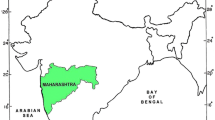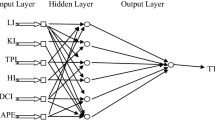Abstract
This paper brings out the interconnection of flash rate density (FRD) with convection and stability parameters over Andhra Pradesh (AP), India. The convection parameters include rainfall, relative humidity, specific humidity, surface air temperature (SAT) and air temperature (at 850 mb). The stability parameters include convective available potential energy (CAPE), lifted index, K-index, total totals index (TTI), humidity index and total precipitable water. Both convective and stability parameters indicate good correlation with lightning activity. SAT and AT 850 mb have shown good correlations with lightning, which is a clear indication of interaction between warm air and dry air. CAPE and TTI have shown strong positive correlation with lightning activity. The correlation coefficient between FRD and CAPE is 0.81. We have also studied the influence of convective and stability parameters during lightning and no lightning activity. Later, we also attempted the estimation of lightning activity by using artificial neural network model. By using convection and stability parameters, six learning algorithms were used for training the artificial neural network. Scaled conjugate gradient backpropagation training algorithm has given the better estimation, whereas resilient backpropagation training algorithm has shown the poor estimation of FRD.



















Similar content being viewed by others
References
Boccippio DJ, Koshak WJ, Blakeslee RJ (2002) Performance assessment of the optical transient detector and lightning imaging sensor. Part I: predicted diurnal variability. J Atmos Ocean Technol 19:1318–1332
Cecil, Daniel J (2006) LIS/OTD 0.5 degree high resolution monthly climatology (HRMC) [indicate subset used]. Dataset available online from the NASA Global Hydrology Resource Center DAAC, Huntsville, Alabama, U.S.A. DOI: http://dx.doi.org/10.5067/LIS/LIS-OTD/DATA303
Chattopadhyay S (2007) Feed forward artificial neural network model to predict the average summer-monsoon rainfall in India. Acta Geophys 55(3):369–382
Chaudhuri S, Chattopadhyay S (2005) Neuro-computing based short range prediction of some meteorological parameters during the pre-monsoon season. Soft Comput 9(5):349–354
Christian HJ, Blakeslee RJ, Boccippio DJ, Boeck WL, Buechler DE, Driscoll KT, Goodman SJ, Hall JM, Koshak WJ, Mach DM, Stewart MF (1999) Global frequency and distribution of lightning as observed from space by the Optical Transient Detector. J. Geophysical Research. 108(D1):4005
Chen LV, Xing Y, Zhang J, Na X, Li Y, Liu T, Cao D, Wang F-Y (2017) Levenberg-Marquardt back propagation training of multilayer neural networks for state estimation of a safety critical cyber-physical system. IEEE Trans Ind Inf 99:1–1
Cömert Z, Kocamaz AF (2017) A study of artificial neural network training algorithms for classification of cardiotocography signals. Bitlis Eren Univ J Sci Technol 7(2):93–103
Das Y (2015) Some aspects of thunderstorm over India during pre-monsoon season: a preliminary report-I. J Geosci Geomat 3(3):68–78
Galway GJ (1956) The Lifted index as a predictor of latent instability. Bull Am Meteor Soc 37:528–529
George GJ (1960) Weather forecasting for aeronautics. Academic Press, New York, p 673
Gomes C, Kadir MZAA (2011) A theoretical approach to estimate the annual lightning hazards on human beings. Atmos Res 101:719–725
Huang G-B (2006) Universal approximation using incremental constructive feed forward networks with random hidden nodes. IEEE Trans Neural Netw 17(4):1–4
Jacovides CP, Yonetani T (1990) An evaluation of stability indices for thunderstorm prediction in greater cyprus. Wether Forcast 5(4):559–569
Johns RH, Doswell CA III (1992) Severe local storms forecasting. Wea Forecast 7:588–612
July Hagan MT, Menhaj MB (1994) Training feedforward networks with the Marquardt algorithm. IEEE Trans Neural Netw IEEE 5(6):989–993
Kandalgaonkar SS, Tinmaker MIR, Kulkarni JR, Nath A, Kulkarni MK (2005a) Spatio-temporal variability of lightning activity over the Indian region. J Geophys Res 110(D11):110–118
Kandalgaonkar SS, Tinmaker MIR, Nath AS, Kulkarni MK, Trimbake HK (2005b) Study of thunderstorm and rainfall activity over the Indian region. Atmosfera 18:91–101
Kunz M (2007) The skill of convective parameters and indices to predict isolated and severe thunderstorms. Nat Hazards Earth Syst Sci 7:327–342
Lavigne T, Liu C, Liu N (2019) How does the trend in thunder days relate to the variation of lightning flash density? J Geophys Res Atmos 124(9):4955–4974
Liou YA, Kar SK (2010) Study of cloud-to-ground lightning and precipitation and their seasonal and geographical characteristics over Taiwan. Atmos Res 95:115–122
Litta A, Mary Idicula S, Mohanty UC (2013) Artificial neural network model in prediction of meteorological parameters during premonsoon thunderstorms. Int J Atmos Sci 10:525–535
Manohar GK, Kesarkar AP (2005) Climatology of thunderstorm activity over the Indian region: III. Latitudinal and seasonal variation. Mausam 56(3):581–592
Manohar GK, Kandalgaonkar SS, Tinmaker MIR (1999) Thunderstorm activity over India and the Indian southwest monsoon. J Geophys Res 104(D4):4169–4188
Miller RC (1967) Notes on analysis and severe storm forecasting procedures of the Military Weather Warning Center. Tech. Report 200, AWS, USAF.[Headquarters, AWS, Scott AFB, 1L 62225]
Moller MF (1993) A scaled conjugate gradient algorithm for fast supervised learning. Neural Netw 6:525–533
Murugavel P, Pawar SD, Gopalakrishan V (2014) Climatology of lightning over Indian region and its relationship with convective available potential energy. Int J Climatol 34:3179–3187
Pinjare LS, Arun Kumar M (2012) Implementation of neural network back propagation training algorithm on FPGA. Int J Comput Appl 52(6):1
Saha UD, Singh SK, Midya RP, Singha AK, Kumar S (2017) Spatio-temporal variability of lightning and convective activity over South/South-East Asia with an emphasis during El Niño and La Niña. Atmos Res 197:150–156
Singh O, Singh J (2015) Lightning fatalities over India: 1979–2011. Meteorol Appl 22(4):770–778
Tinmaker MIR, Ali K, Beig G (2010) Relationship between lightning activity over Peninsular India and sea surface temperature. J Appl Meteorol Climatol 49:828–835
Tinmaker MIR, Aslam MY, Chate DM (2015) Lightning activity and its association with rainfall and convective available potential energy over Maharashtra, India. Nat Hazards 77:293
Tyagi A (2007) Thunderstorm climatology over Indian Region. Mausam 58(2):189–212
Vaddadi S, Remella VV, Vaddadi RS (2015) Dermatological manifestation of lightning injury: a case report. Am J Med Sci 2(1):30–33
Weng LY, Omar J, Siah YK, Ahmed SK, Abidin IZ (2010) Lightning forecasting using ANN-BP & Radiosonde. In: Proceeding of International conference onintellegent computing and cognitive informatics, Kulala Lumpur, Malaysia, pp 153–155
Wilks DS (2006) Statistical methods in the atmospheric sciences, 2nd edn. Academic Press, London
Acknowledgements
The data used in this work were supported by Era-Interim data from ECMWF satellite; flash rates data from LIS-TRMM satellite; GPCC rainfall data from NCEP; and NCAR re-analysis satellite data from NOAA, USA. This work is supported by CSIR-SRF, Government of India, under the file no. 09/1068(0001)/2018-EMR-I.
Funding
There are no funding sources for this article work.
Author information
Authors and Affiliations
Corresponding author
Ethics declarations
Conflict of Interest
The authors declare that there is no conflict of interests regarding the publication of this paper.
Rights and permissions
About this article
Cite this article
Umakanth, N., Satyanarayana, G.C., Simon, B. et al. Impact of convection and stability parameters on lightning activity over Andhra Pradesh, India. Acta Geophys. 68, 1845–1866 (2020). https://doi.org/10.1007/s11600-020-00479-0
Received:
Accepted:
Published:
Issue Date:
DOI: https://doi.org/10.1007/s11600-020-00479-0




